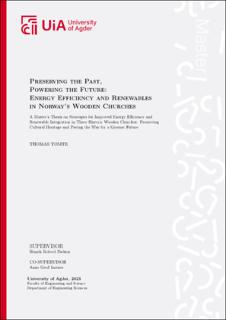| dc.description.abstract | This master’s thesis explores the potential for energy efficiency in three wooden churches built in the 19th century in the southern part of Norway. Specifically, the thesis focuses on the three churches Eide, Landvik, and Grimstad, all owned and operated by the Grimstad Church Council. Each church presents its own unique set of challenges related to heating and overall energy efficiency, largely due to their varying sizes. The thesis examines the impact of various energy efficiency measures and explores the possibilities of implementing renewable energy systems such as solar panels and geothermal energy.
At Eide church, three different configurations of solar panel systems have been studied, and the thesis also considers how the implementation of a battery can increase self-consumption of the church’s electricity production. PVsyst has been used to simulate these alternatives. The thesis highlights potential energy savings in the range of 30-50% by lowering the temper- ature, making simple structural upgrades, and upgrading the heating control system in an annex adjacent to the church. A combination of solar panels and energy efficiency measures could make the church energy positive.
In Landvik church, the energy calculation program Simien has been used to assess the effects of various energy efficiency measures. Among the measures mentioned are retrofitting of roof, wall, and floor insulation, window replacement, lighting system upgrades, and temperature reduction. The results show that the church can achieve annual energy savings of up to 40% of the current energy consumption by combining multiple measures.
Furthermore, this master’s thesis suggests that implementing a 25.5 kW liquid-to-water heat pump in Grimstad church, supplied from two energy wells, could cover 90% of the church’s energy consumption and thus save an equivalent proportion of biofuel oil, over 13 000 liters annually.
The thesis identifies a significant need to educate and inform the church’s staff about energy efficiency and points out that too much responsibility is placed on those working for the church’s daily operations.
Based on the large number of churches in Norway, the results of this study have significant transferability, and the potential for energy savings at a national and Nordic level is consid- erable. In conclusion, the thesis emphasizes that the approach requires a balance between advanced technologies, awareness, and basic practices. | |
